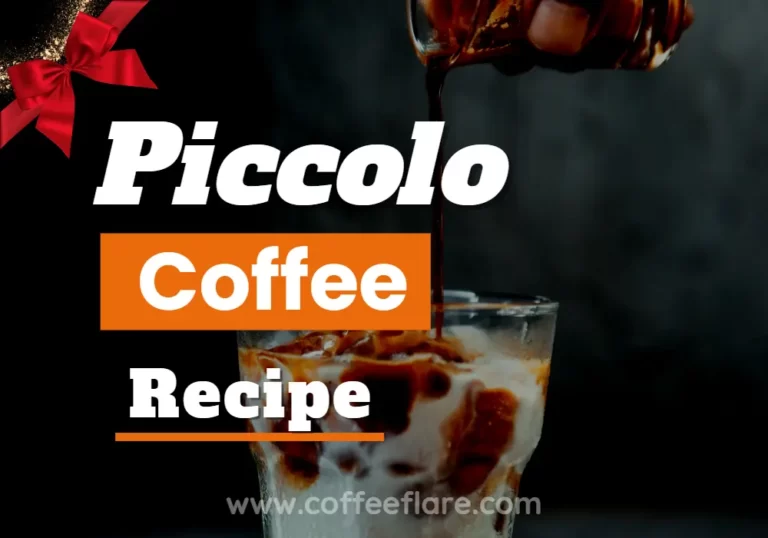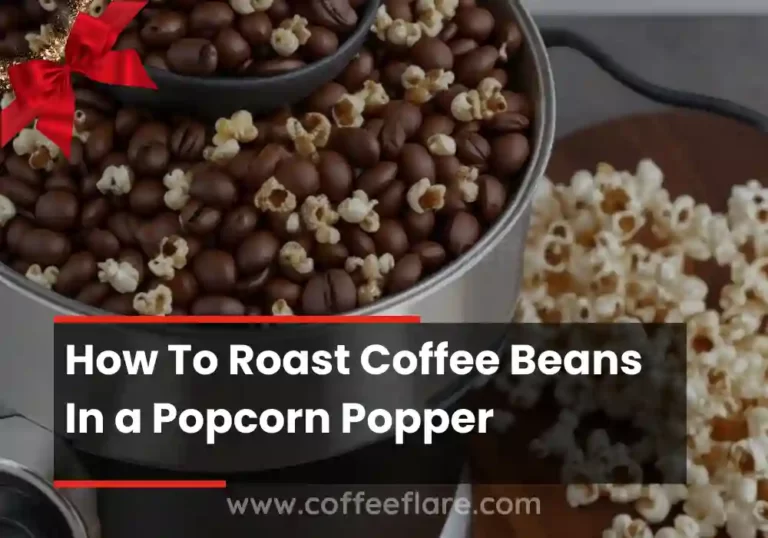How to Make Coffee Without a Filter? Easy and Simple
Coffeeflare is reader-supported. When you buy through links on our site, we may earn an affiliate commission.

Discover how to make coffee without a filter using simple materials and methods. Learn about the benefits of making coffee without a filter, including a fuller flavor and sustainability. Try out different methods like using a French press or percolator, and find tips and tricks for making the perfect cup of coffee. With these methods, you’ll be able to make coffee without a filter anytime, anywhere.
When it comes to making a great cup of coffee, it’s easy to rely on the tried-and-true method of using a filter. But what if you don’t have any filters on hand, or you just want to try something new? Making coffee without a filter is actually a lot easier than you might think, and it can even lead to a richer, fuller flavor in your cup. Here’s how to do it.
Benefits of Making Coffee Without a Filter
One of the main benefits of making coffee without a filter is the potential for a fuller, more complex flavor. Without a filter to remove some of the oils and other particles from the coffee, you may find that your cup has a richer, more intense taste. Additionally, making coffee without a filter is a more sustainable option, since you won’t have to constantly buy and dispose of paper filters.
Why Is It Important To Filter Coffee?
There are a few reasons why filtering coffee can be important:
- Removing impurities: Filtering coffee can help to remove impurities such as coffee grounds, oils, and other particles from the final product. This can result in a smoother, cleaner-tasting cup of coffee.
- Improved flavor: Filtering coffee can also help to improve the flavor of the final product. By removing certain impurities, a filter can help to bring out the desired flavors in the coffee beans.
- Easier brewing: Filtering coffee can also make the brewing process more accessible since it helps to separate the coffee grounds from the water. This can be especially useful if you use a method that requires the grounds to be removed after brewing, such as a French press.
- Health benefits: Some people believe that filtering coffee can have health benefits, as it can help to remove compounds such as cafestol and kahweol, which have been linked to an increased risk of heart disease. However, more research is needed to confirm this.
Overall, filtering coffee can be important for a variety of reasons, including improved flavor, easier brewing, and potentially even health benefits. However, it’s important to note that filtering coffee is not necessary in order to enjoy a great cup of coffee, and there are other methods for making coffee that does not require a filter.
What Type of Material Is Best for Filtering Coffee?
There are a few different materials that are commonly used for filtering coffee, each with its own pros and cons:
- Paper filters: Paper filters are widely available and relatively inexpensive. They are also easy to use and can help to remove oils and other impurities from the coffee, resulting in a clean, smooth flavor. However, paper filters can be wasteful, as they must be discarded after each use.
- Metal filters: Metal filters are durable and can be reused many times. They are also effective at removing impurities from the coffee. However, some people find that metal filters can alter the flavor of the coffee, and they may be more difficult to clean than paper filters.
- Cloth filters: Cloth filters can be made from a variety of materials, such as cotton or hemp. They are reusable and environmentally friendly, and some people find they produce a more prosperous, fuller-flavored cup of coffee. However, cloth filters may be more difficult to clean than paper or metal filters, and they may not be as effective at removing impurities from the coffee.
Ultimately, the best material for filtering coffee depends on your preferences and needs. Some people prefer the convenience of paper filters, while others may prefer the taste and sustainability of metal or cloth filters. It’s a good idea to try out a few different options to see which one works best for you.
Materials Needed
To make coffee without a filter, you’ll need a few basic materials:
- A coffee pot or French press
- Water
- Coffee beans
- A heat source (such as a stovetop or electric kettle)
Step-by-Step Instructions
- Grind your coffee beans to a medium-coarse consistency. You’ll want the grinds to be slightly larger than you would use for a filtered coffee, as this will help to prevent them from passing through the coffee pot or French press.
- Boil the water. If you’re using a stovetop method, bring a pot of water to a boil. If you’re using an electric kettle, fill it with water and turn it on.
- Place the ground coffee into your coffee pot or French press.
- Pour the hot water over the coffee grounds, making sure to evenly distribute the water. If you’re using a French press, let the coffee steep for about 4-5 minutes before pressing down on the plunger to separate the grounds from the liquid.
- Pour the coffee into your mug and enjoy!
Tips and Tricks
Here are a few tips and tricks to help you make the perfect cup of coffee without a filter:
- Experiment with different brewing times to find the flavor that you like best. A longer brewing time will result in a stronger, more intense cup of coffee, while a shorter brewing time will be milder.
- Use a medium-coarse grind for the best results. This will help to prevent the coffee grounds from passing through the coffee pot or French press, while still allowing for maximum flavor extraction.
- If you’re using a French press, try using a pre-heated press to keep your coffee hot for longer. Simply fill the press with hot water and let it sit for a minute or two before adding the coffee grounds and hot water.
- If you’re using a coffee pot, you can try using a paper towel or cheesecloth as a makeshift filter. Place the paper towel or cheesecloth over the spout of the coffee pot and pour the coffee through it as you would with a regular filter. This will help to catch any more enormous coffee grounds that may have escaped the pot or French press.
With these simple steps, you’ll be able to make a delicious cup of coffee without the need for a filter. So the next time you’re out of filters or just looking to try something new, give this method a try!
Alternative Methods for Making Coffee Without a Filter
In addition to using a coffee pot or French press, there are a few other methods you can use to make coffee without a filter. Here is a couple to try:
Percolator
A percolator is a type of coffee pot that uses steam pressure to force hot water up through a tube and over the coffee grounds. To use a percolator, you’ll need to fill the pot with water, add your coffee grounds to the basket, and place the pot on a heat source. As the water boils, it will be forced up through the tube and over the coffee grounds, extracting the flavor as it goes. Once the percolator has finished brewing, the coffee will be ready to serve.
Cold brew
If you’re looking for a more mellow, less acidic cup of coffee, you might want to try making a cold brew. To do this, you’ll need to mix together ground coffee and cold water in a jar or container and let it steep in the fridge for at least 12 hours (though some people prefer to let it steep for as long as 24 hours). Once the steeping time is up, simply strain out the coffee grounds and serve the coffee over ice or heat it up if you prefer it hot.
Conclusion
In conclusion, making coffee without a filter is a simple and rewarding process that can lead to a delicious, full-flavored cup of coffee. Whether you prefer using a French press, coffee pot, percolator, or cold brew method, there are plenty of options to choose from. Each method has its own pros and cons, so it’s a good idea to try out a few different ones to see which one works best for you.
With a little experimentation and these easy tips and tricks, you’ll be able to make coffee without a filter anytime, anywhere. So, next time when you are out of filters or just looking to try something new, don’t hesitate to give these methods a try and enjoy a great cup of coffee!
Also, Check out the Brew the Best: Piccolo Coffee Recipe
FAQ’s
Can I make coffee without a filter if I don’t have a French press or coffee pot?
Yes, there are other methods you can use to make coffee without a filter. For example, you can try using a percolator or making a cold brew.
Is it possible to make coffee without a filter if I only have finely ground coffee beans?
It is generally recommended to use a medium-coarse grind when making coffee without a filter, as this will help to prevent the coffee grounds from passing through the coffee pot or French press. However, if you only have finely ground beans, you can still give it a try. You may need to use a paper towel or cheesecloth as a makeshift filter to catch any stray grounds, and you may need to experiment with different brewing times to find the flavor that you like best.
Will making coffee without a filter result in a stronger cup of coffee?
It’s possible that making coffee without a filter could result in a stronger cup of coffee since the oils and other particles that are usually removed by a filter will remain in the cup. However, the strength of your coffee will also depend on factors such as the type of beans you use, the brewing time, and the grind size.
Is it better to make coffee without a filter in terms of sustainability?
Making coffee without a filter can be a more sustainable option since you won’t have to constantly buy and dispose of paper filters. However, it’s important to note that other factors, such as the type of beans you use and the method you choose, can also impact the sustainability of your coffee.
Can I make coffee without a filter if I don’t have a heat source?
To make coffee without a filter, you’ll need a heat source to boil the water. If you don’t have access to a stovetop or electric kettle, it may not be possible to make coffee without a filter using traditional methods. However, you could try making a cold brew, which does not require a heat source.






